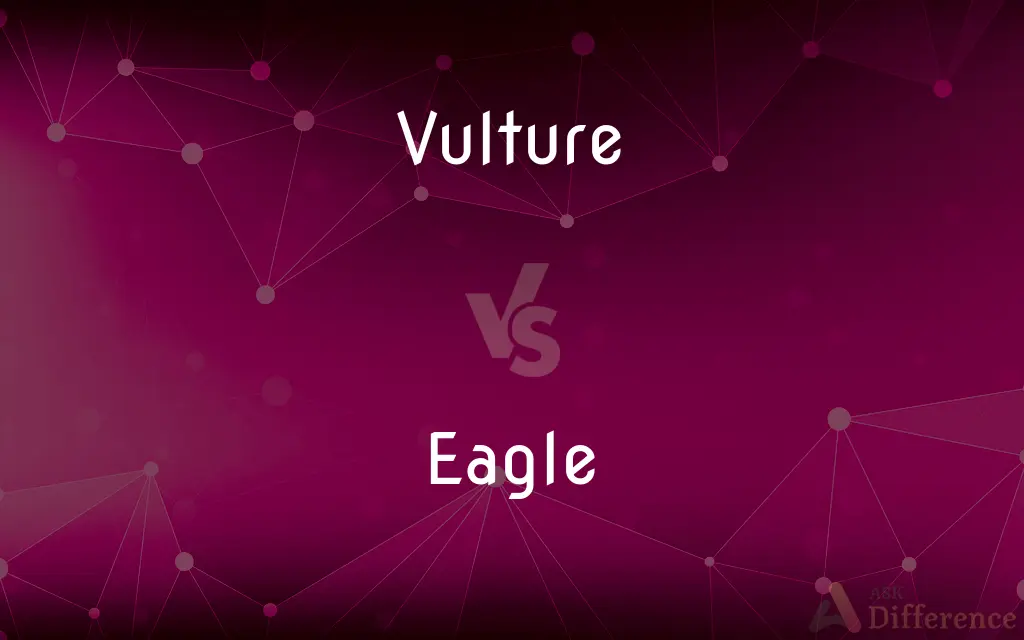Vulture vs. Eagle — What's the Difference?
By Tayyaba Rehman — Updated on September 5, 2023

Difference Between Vulture and Eagle
Table of Contents
ADVERTISEMENT
Key Differences
Vultures and eagles both belong to the family of birds of prey, making them raptors. However, their roles in the ecosystem differ greatly. Vultures are primarily scavengers, which means they feed mostly on dead animals. Eagles, in contrast, are skilled hunters, preying on live animals and often showcasing their incredible agility and speed in the process.
Vultures possess a bald head, an evolutionary trait that helps keep them clean while they're feeding on carcasses. Eagles, on the other hand, have feathered heads, and their appearance is often associated with majesty and strength. The beak of a vulture is designed to tear open carcasses, whereas an eagle's beak is sharp and hooked, perfect for grabbing and tearing flesh from their prey.
In terms of habitat and behavior, vultures are often seen circling high in the sky, using their keen eyesight to spot carrion. They play a crucial role in the ecosystem by cleaning up carcasses and preventing the spread of diseases. Eagles, however, are seen as symbols of freedom and power. They soar at great altitudes, often using thermal currents, and perch on high vantage points to spot their prey.
Lastly, there are multiple species of both vultures and eagles distributed across different continents. While vultures can be found almost everywhere, except Antarctica and Oceania, eagles have a more widespread distribution, inhabiting various ecosystems from mountains to coastlines.
Comparison Chart
Feeding Habits
Scavengers
Hunters
ADVERTISEMENT
Appearance
Bald head, broad wings
Feathered head, sharp talons, and beak
Role in Ecosystem
Clean up carcasses
Control populations of small mammals, birds, and reptiles
Habitat & Behavior
Often seen circling in the sky
Perch on high points, soaring high for prey
Distribution
Almost everywhere except Antarctica and Oceania
Widespread, various ecosystems
Compare with Definitions
Vulture
Recognizable by its bald head and often large wingspan.
The vulture's bald head is an adaptation for hygiene.
Eagle
A large bird of prey with keen eyesight and powerful flying abilities.
The eagle swooped down to snatch its prey with unparalleled precision.
Vulture
A bird of prey feeding chiefly on carrion.
The vulture patiently waited for the lion to leave before approaching the carcass.
Eagle
Represents freedom and strength in many cultures.
The bald eagle is a symbol of the United States.
Vulture
Often seen in groups, especially around a food source.
A group of vultures on the ground usually indicates a nearby carcass.
Eagle
Often nests in high places like cliffs or treetops.
The eagle's nest atop the cliff had a clear view of the valley below.
Vulture
Plays a vital role in ecosystems by cleaning up dead animals.
Without the vulture, many ecosystems would be overwhelmed by decaying animals.
Eagle
Equipped with sharp talons and a strong beak for hunting.
With its sharp beak, the eagle tore into the fish.
Vulture
Possesses strong stomach acids to digest carrion and prevent infections.
The vulture's stomach can neutralize harmful bacteria from rotting meat.
Eagle
Has various species distributed globally.
The golden eagle is admired for its majestic appearance.
Vulture
A vulture is a bird of prey that scavenges on carrion. There are 23 extant species of vulture (including Condors).
Eagle
Eagle is the common name for many large birds of prey of the family Accipitridae. Eagles belong to several groups of genera, some of which are closely related.
Vulture
Any of various large birds of prey characteristically having dark plumage and a featherless head and neck and generally feeding on carrion. Species found in the Americas are in the family Cathartidae, and those found in Eurasia and Africa are in the family Accipitridae.
Eagle
Any of various large diurnal birds of prey of the family Accipitridae, including members of the genera Aquila and Haliaeetus, characterized by broad wings, a hooked bill, keen vision, and soaring flight.
Vulture
A person of a rapacious, predatory, or profiteering nature.
Eagle
A representation of an eagle used as an emblem or insignia.
Vulture
Any of several carrion-eating birds of the families Accipitridae and Cathartidae.
Eagle
A gold coin formerly used in the United States, stamped with an eagle on the reverse side and having a face value of ten dollars.
Vulture
A person who profits from the suffering of others.
Within ten minutes of the accident, the vultures appeared and were organizing lawsuits.
Eagle
(Sports) A golf score of two strokes under par on a hole.
Vulture
To circle around one's target as if one were a vulture.
Rudy vultured when asking the girl out.
Eagle
To shoot (a hole in golf) in two strokes under par.
Vulture
(obsolete) ravenous; rapacious
Eagle
To score an eagle in golf.
Vulture
Any one of numerous species of rapacious birds belonging to Vultur, Cathartes, Catharista, and various other genera of the family Vulturidæ.
Eagle
Any of several large carnivorous and carrion-eating birds in the family Accipitridae, having a powerful hooked bill and keen vision.
Vulture
Any of various large diurnal birds of prey having naked heads and weak claws and feeding chiefly on carrion
Eagle
A gold coin with a face value of ten dollars, formerly used in the United States.
Vulture
Someone who attacks in search of booty
Eagle
A 13th-century coin minted in Europe and circulated in England as a debased sterling silver penny, outlawed under Edward I of England.
Eagle
(golf) A score of two under par for a hole.
Eagle
(golf) To score an eagle.
Eagle
Any large, rapacious bird of the Falcon family, esp. of the genera Aquila and Haliæetus. The eagle is remarkable for strength, size, graceful figure, keenness of vision, and extraordinary flight. The most noted species are the golden eagle (Aquila chrysaëtus); the imperial eagle of Europe (Aquila mogilnik or Aquila imperialis); the American bald eagle (Haliæetus leucocephalus); the European sea eagle (Haliæetus albicilla); and the great harpy eagle (Thrasaetus harpyia). The figure of the eagle, as the king of birds, is commonly used as an heraldic emblem, and also for standards and emblematic devices. See Bald eagle, Harpy, and Golden eagle.
Eagle
A gold coin of the United States, of the value of ten dollars.
Eagle
A northern constellation, containing Altair, a star of the first magnitude. See Aquila.
Eagle
The figure of an eagle borne as an emblem on the standard of the ancient Romans, or so used upon the seal or standard of any people.
Though the Roman eagle shadow thee.
Eagle
Any of various large keen-sighted diurnal birds of prey noted for their broad wings and strong soaring flight
Eagle
(golf) a score of two strokes under par on a hole
Eagle
A former gold coin in the United States worth 10 dollars
Eagle
An emblem representing power;
The Roman eagle
Eagle
Shoot in two strokes under par
Common Curiosities
What do Vultures primarily eat?
Vultures are scavengers, feeding mainly on dead animals or carrion.
How does an Eagle's diet differ from a Vulture's?
Eagles are hunters, preying mainly on live animals.
Which bird is often seen as a national symbol?
The eagle, especially the bald eagle in the U.S.
Which bird is known for its exceptional eyesight?
Both have keen eyesight, but eagles are especially renowned for it.
Why do Vultures have bald heads?
A bald head helps vultures stay clean while feeding on carcasses.
How do Eagles catch their prey?
Eagles use their sharp talons and beak to snatch and consume prey.
Are Eagles larger than Vultures?
It depends on the species, but both can be quite large with expansive wingspans.
Which bird is more likely to be seen soaring high in the sky?
Both can be seen soaring, but vultures often circle high, especially when locating carrion.
Are Vultures found on every continent?
No, vultures are absent in Antarctica and Oceania.
Can Vultures hunt live prey?
While primarily scavengers, some vultures can catch live prey if needed.
Do Eagles have any cultural significance?
Yes, eagles are symbols of power, freedom, and nobility in many cultures.
Which bird has a broader wingspan, Vulture or Eagle?
It varies by species, but some vultures have particularly broad wingspans for soaring.
Do Eagles and Vultures have a specific mating season?
Yes, both have specific breeding seasons depending on their habitats and species.
Are Vultures considered endangered?
Some species of vultures are threatened or endangered due to various factors.
How do Vultures help the environment?
Vultures clean up dead animals, preventing the spread of diseases.
Share Your Discovery

Previous Comparison
Conceptualisation vs. Conceptualization
Next Comparison
Tonight vs. TodayAuthor Spotlight
Written by
Tayyaba RehmanTayyaba Rehman is a distinguished writer, currently serving as a primary contributor to askdifference.com. As a researcher in semantics and etymology, Tayyaba's passion for the complexity of languages and their distinctions has found a perfect home on the platform. Tayyaba delves into the intricacies of language, distinguishing between commonly confused words and phrases, thereby providing clarity for readers worldwide.














































